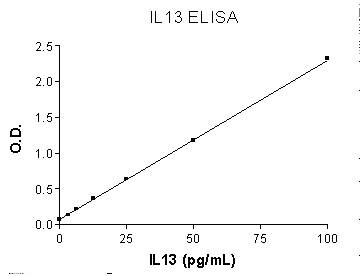Human IL-13 ELISA Set (without plates) (ab47353)
Overview
-
Product name
Human IL-13 ELISA Set (without plates) -
Sample type
Cell culture supernatant, Serum, Plasma -
Assay type
Sandwich (quantitative) -
Sensitivity
Range
3.21 pg/ml - 100 pg/mlAssay duration
Multiple steps standard assaySpecies reactivity
Reacts with: HumanProduct overview
Abcam’s IL-13 Human in vitro ELISA Set is designed for the quantitative measurement of IL-13 in cell culture supernatants, buffered solutions, serum, plasma and other body fluids.
This ELISA Set is intended to measure human IL-13 in cell -culture supernatants, as well as in serum and plasma samples. The enclosed procedures provide general guidelines for ELISA preparation. This procedure may need some optimization depending on the plastic, matrix, standard range.
The IL-13 ELISA Set includes both the capture and the detection antibodies as well as Horse-Radish peroxidase conjugated Streptavidin (HRP-Strep) and TMB which are the reagents used in the colour development step.
Recognizes both natural and recombinant human IL-13.
Tested applications
Suitable for: Sandwich ELISAmore detailsPlatform
ReagentsProperties
-
Storage instructions
Store at +4°C. Please refer to protocols. -
Components Identifier 5 x 96 tests 10 x 96 tests 15 x 96 tests Detection biotinylated anti-IL-13 antibody 1 x 0.55ml 2 x 0.55ml 3 x 0.55ml IL-13 Capture antibody 1 x 0.5ml 2 x 0.5ml 3 x 0.5ml IL-13 standard Yellow 5 vials 10 vials 15 vials Chromogen TMB Substrate Solution 2 vials 4 vials 6 vials Streptavidin-HRP 1 vial 2 vials 3 vials -
Research areas
-
Relevance
Human IL-13 was originally identified by differential screening of an anti CD28 activated human peripheral blood mononuclear cell cDNA library as an induction specific novel cytokine. It was also isolated from cDNA libraries of human T cell clones using the murine IL-13 (P600) cDNA as a probe. Human IL-13, a pleiotropic cytokine, is produced by activated Th0, Th1 like, Th2 like, and CD8 T cells. The gene for human IL-13 maps to chromosome 5 and is closely linked to the genes for IL3, IL4, IL5, and GMCSF. IL-13 inhibits proinflammatory cytokine production and stimulates antibody production. It induces proliferation in the human pre myeloid cell line TF1. IL-13 has multiple effects on the differentiation and functions of monocytes and macrophages. It suppresses cytotoxic functions and induces changes in the morphology of human monocytes and in the phenotype of human monocytes and B cells by upregulating MHC class II expression. IL-13 will also decrease the production of nitric oxide by activated murine macrophages, leading to impaired parasiticidal activity. Human and mouse interleukin 13 share approximately 58% amino acid sequence identity. Although human and mouse IL-13 are equally active on human cells, human IL-13 is much less active than mouse IL-13 on mouse cells. Human IL-13 and human IL-4 also share approximately 30% sequence homology and have similar biological functions. -
Cellular localization
Secreted -
Alternative names
- ALRH
- BHR1
- IL13
see all -
Database links
- Entrez Gene: 3596 Human
- SwissProt: P35225 Human
Properties
-
Storage instructions
Store at +4°C. Please refer to protocols. -
Components Identifier 5 x 96 tests 10 x 96 tests 15 x 96 tests Detection biotinylated anti-IL-13 antibody 1 x 0.55ml 2 x 0.55ml 3 x 0.55ml IL-13 Capture antibody 1 x 0.5ml 2 x 0.5ml 3 x 0.5ml IL-13 standard Yellow 5 vials 10 vials 15 vials Chromogen TMB Substrate Solution 2 vials 4 vials 6 vials Streptavidin-HRP 1 vial 2 vials 3 vials -
Research areas
-
Relevance
Human IL-13 was originally identified by differential screening of an anti CD28 activated human peripheral blood mononuclear cell cDNA library as an induction specific novel cytokine. It was also isolated from cDNA libraries of human T cell clones using the murine IL-13 (P600) cDNA as a probe. Human IL-13, a pleiotropic cytokine, is produced by activated Th0, Th1 like, Th2 like, and CD8 T cells. The gene for human IL-13 maps to chromosome 5 and is closely linked to the genes for IL3, IL4, IL5, and GMCSF. IL-13 inhibits proinflammatory cytokine production and stimulates antibody production. It induces proliferation in the human pre myeloid cell line TF1. IL-13 has multiple effects on the differentiation and functions of monocytes and macrophages. It suppresses cytotoxic functions and induces changes in the morphology of human monocytes and in the phenotype of human monocytes and B cells by upregulating MHC class II expression. IL-13 will also decrease the production of nitric oxide by activated murine macrophages, leading to impaired parasiticidal activity. Human and mouse interleukin 13 share approximately 58% amino acid sequence identity. Although human and mouse IL-13 are equally active on human cells, human IL-13 is much less active than mouse IL-13 on mouse cells. Human IL-13 and human IL-4 also share approximately 30% sequence homology and have similar biological functions. -
Cellular localization
Secreted -
Alternative names
- ALRH
- BHR1
- IL13
see all -
Database links
- Entrez Gene: 3596 Human
- SwissProt: P35225 Human







